Human Resource Management Report: Motivational Theories and Home Cosy
VerifiedAdded on 2023/03/20
|22
|5401
|63
Report
AI Summary
This report delves into the application of motivational theories and organizational culture within the context of Home Cosy, a mailing order shopping organization. It begins by recommending McClelland’s Three Needs of Motivation for Saturday staff, emphasizing the needs for achievement, affiliation, and power. For flexible staff, Herzberg’s five factors of job satisfaction, including achievement, recognition, work itself, responsibility, and advancement, are proposed. The report then suggests three ways for self-motivation, including setting goals, learning new skills, and seeking feedback. Learning new skills is recommended for Home Cosy staff to enhance self-motivation. Finally, the report explores key types of organizational culture, recommending a culture that fosters innovation and employee growth and development. This comprehensive analysis provides practical strategies for improving employee engagement, productivity, and overall organizational success at Home Cosy.
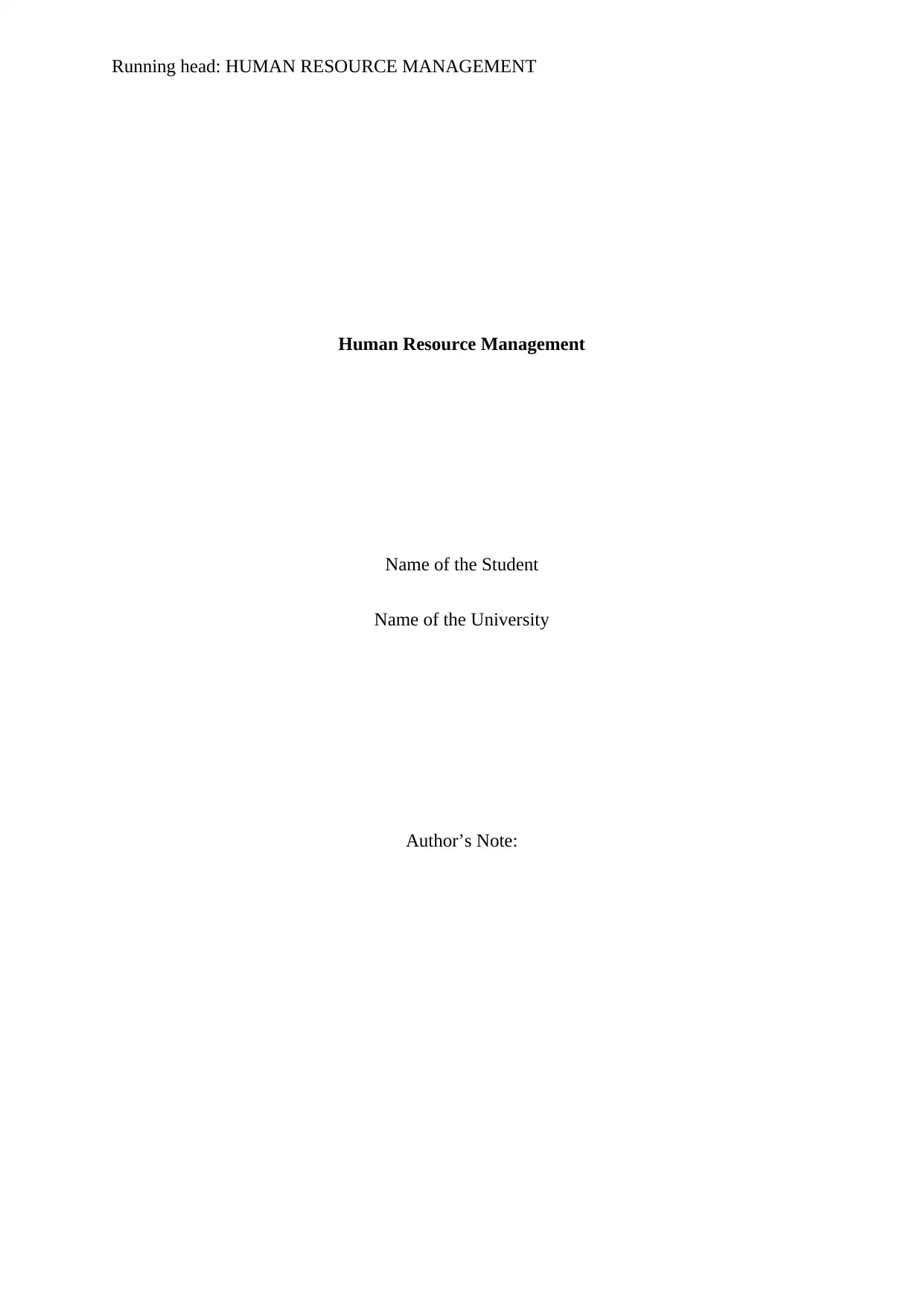
Running head: HUMAN RESOURCE MANAGEMENT
Human Resource Management
Name of the Student
Name of the University
Author’s Note:
Human Resource Management
Name of the Student
Name of the University
Author’s Note:
Paraphrase This Document
Need a fresh take? Get an instant paraphrase of this document with our AI Paraphraser
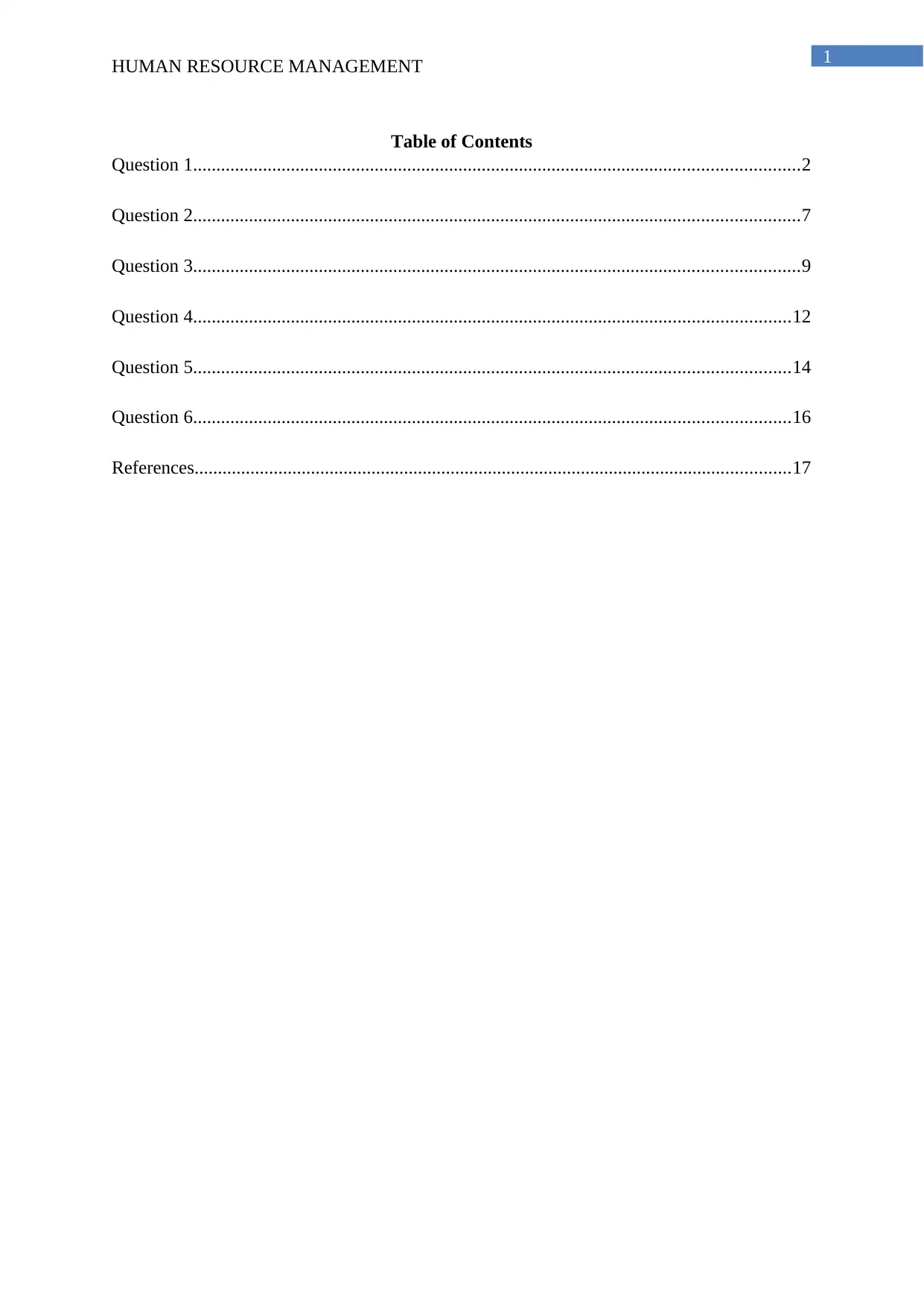
1
HUMAN RESOURCE MANAGEMENT
Table of Contents
Question 1..................................................................................................................................2
Question 2..................................................................................................................................7
Question 3..................................................................................................................................9
Question 4................................................................................................................................12
Question 5................................................................................................................................14
Question 6................................................................................................................................16
References................................................................................................................................17
HUMAN RESOURCE MANAGEMENT
Table of Contents
Question 1..................................................................................................................................2
Question 2..................................................................................................................................7
Question 3..................................................................................................................................9
Question 4................................................................................................................................12
Question 5................................................................................................................................14
Question 6................................................................................................................................16
References................................................................................................................................17
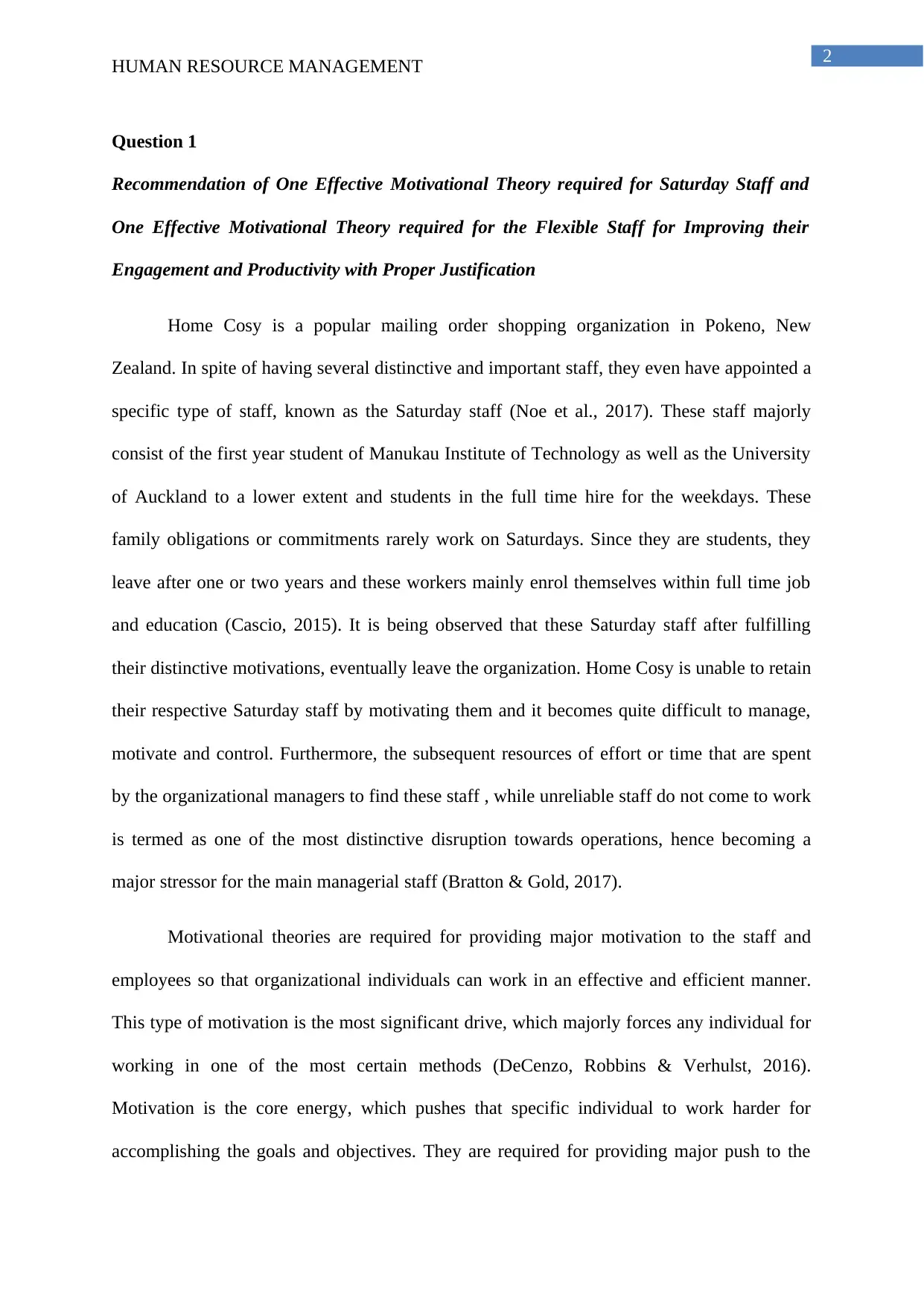
2
HUMAN RESOURCE MANAGEMENT
Question 1
Recommendation of One Effective Motivational Theory required for Saturday Staff and
One Effective Motivational Theory required for the Flexible Staff for Improving their
Engagement and Productivity with Proper Justification
Home Cosy is a popular mailing order shopping organization in Pokeno, New
Zealand. In spite of having several distinctive and important staff, they even have appointed a
specific type of staff, known as the Saturday staff (Noe et al., 2017). These staff majorly
consist of the first year student of Manukau Institute of Technology as well as the University
of Auckland to a lower extent and students in the full time hire for the weekdays. These
family obligations or commitments rarely work on Saturdays. Since they are students, they
leave after one or two years and these workers mainly enrol themselves within full time job
and education (Cascio, 2015). It is being observed that these Saturday staff after fulfilling
their distinctive motivations, eventually leave the organization. Home Cosy is unable to retain
their respective Saturday staff by motivating them and it becomes quite difficult to manage,
motivate and control. Furthermore, the subsequent resources of effort or time that are spent
by the organizational managers to find these staff , while unreliable staff do not come to work
is termed as one of the most distinctive disruption towards operations, hence becoming a
major stressor for the main managerial staff (Bratton & Gold, 2017).
Motivational theories are required for providing major motivation to the staff and
employees so that organizational individuals can work in an effective and efficient manner.
This type of motivation is the most significant drive, which majorly forces any individual for
working in one of the most certain methods (DeCenzo, Robbins & Verhulst, 2016).
Motivation is the core energy, which pushes that specific individual to work harder for
accomplishing the goals and objectives. They are required for providing major push to the
HUMAN RESOURCE MANAGEMENT
Question 1
Recommendation of One Effective Motivational Theory required for Saturday Staff and
One Effective Motivational Theory required for the Flexible Staff for Improving their
Engagement and Productivity with Proper Justification
Home Cosy is a popular mailing order shopping organization in Pokeno, New
Zealand. In spite of having several distinctive and important staff, they even have appointed a
specific type of staff, known as the Saturday staff (Noe et al., 2017). These staff majorly
consist of the first year student of Manukau Institute of Technology as well as the University
of Auckland to a lower extent and students in the full time hire for the weekdays. These
family obligations or commitments rarely work on Saturdays. Since they are students, they
leave after one or two years and these workers mainly enrol themselves within full time job
and education (Cascio, 2015). It is being observed that these Saturday staff after fulfilling
their distinctive motivations, eventually leave the organization. Home Cosy is unable to retain
their respective Saturday staff by motivating them and it becomes quite difficult to manage,
motivate and control. Furthermore, the subsequent resources of effort or time that are spent
by the organizational managers to find these staff , while unreliable staff do not come to work
is termed as one of the most distinctive disruption towards operations, hence becoming a
major stressor for the main managerial staff (Bratton & Gold, 2017).
Motivational theories are required for providing major motivation to the staff and
employees so that organizational individuals can work in an effective and efficient manner.
This type of motivation is the most significant drive, which majorly forces any individual for
working in one of the most certain methods (DeCenzo, Robbins & Verhulst, 2016).
Motivation is the core energy, which pushes that specific individual to work harder for
accomplishing the goals and objectives. They are required for providing major push to the
⊘ This is a preview!⊘
Do you want full access?
Subscribe today to unlock all pages.

Trusted by 1+ million students worldwide
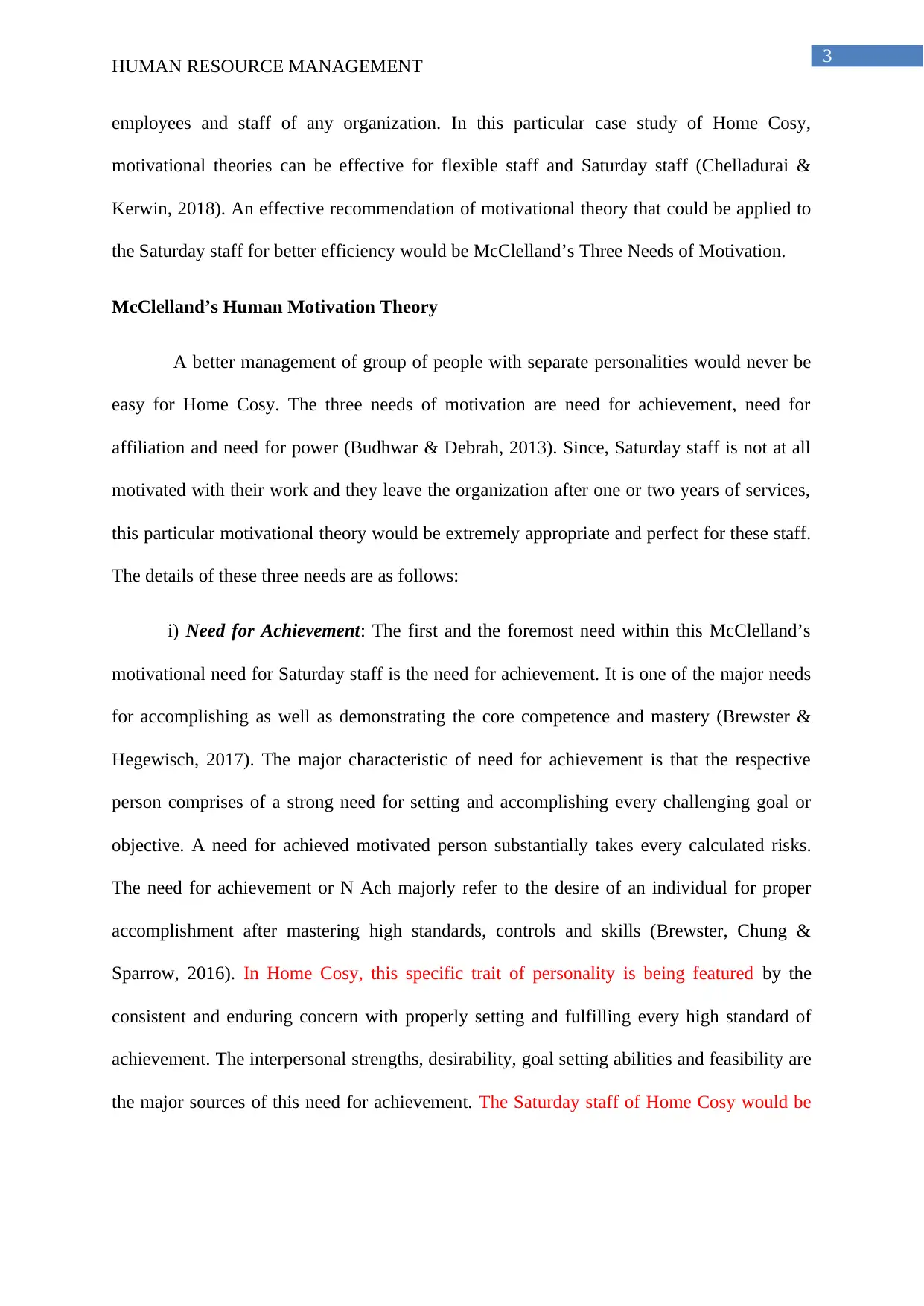
3
HUMAN RESOURCE MANAGEMENT
employees and staff of any organization. In this particular case study of Home Cosy,
motivational theories can be effective for flexible staff and Saturday staff (Chelladurai &
Kerwin, 2018). An effective recommendation of motivational theory that could be applied to
the Saturday staff for better efficiency would be McClelland’s Three Needs of Motivation.
McClelland’s Human Motivation Theory
A better management of group of people with separate personalities would never be
easy for Home Cosy. The three needs of motivation are need for achievement, need for
affiliation and need for power (Budhwar & Debrah, 2013). Since, Saturday staff is not at all
motivated with their work and they leave the organization after one or two years of services,
this particular motivational theory would be extremely appropriate and perfect for these staff.
The details of these three needs are as follows:
i) Need for Achievement: The first and the foremost need within this McClelland’s
motivational need for Saturday staff is the need for achievement. It is one of the major needs
for accomplishing as well as demonstrating the core competence and mastery (Brewster &
Hegewisch, 2017). The major characteristic of need for achievement is that the respective
person comprises of a strong need for setting and accomplishing every challenging goal or
objective. A need for achieved motivated person substantially takes every calculated risks.
The need for achievement or N Ach majorly refer to the desire of an individual for proper
accomplishment after mastering high standards, controls and skills (Brewster, Chung &
Sparrow, 2016). In Home Cosy, this specific trait of personality is being featured by the
consistent and enduring concern with properly setting and fulfilling every high standard of
achievement. The interpersonal strengths, desirability, goal setting abilities and feasibility are
the major sources of this need for achievement. The Saturday staff of Home Cosy would be
HUMAN RESOURCE MANAGEMENT
employees and staff of any organization. In this particular case study of Home Cosy,
motivational theories can be effective for flexible staff and Saturday staff (Chelladurai &
Kerwin, 2018). An effective recommendation of motivational theory that could be applied to
the Saturday staff for better efficiency would be McClelland’s Three Needs of Motivation.
McClelland’s Human Motivation Theory
A better management of group of people with separate personalities would never be
easy for Home Cosy. The three needs of motivation are need for achievement, need for
affiliation and need for power (Budhwar & Debrah, 2013). Since, Saturday staff is not at all
motivated with their work and they leave the organization after one or two years of services,
this particular motivational theory would be extremely appropriate and perfect for these staff.
The details of these three needs are as follows:
i) Need for Achievement: The first and the foremost need within this McClelland’s
motivational need for Saturday staff is the need for achievement. It is one of the major needs
for accomplishing as well as demonstrating the core competence and mastery (Brewster &
Hegewisch, 2017). The major characteristic of need for achievement is that the respective
person comprises of a strong need for setting and accomplishing every challenging goal or
objective. A need for achieved motivated person substantially takes every calculated risks.
The need for achievement or N Ach majorly refer to the desire of an individual for proper
accomplishment after mastering high standards, controls and skills (Brewster, Chung &
Sparrow, 2016). In Home Cosy, this specific trait of personality is being featured by the
consistent and enduring concern with properly setting and fulfilling every high standard of
achievement. The interpersonal strengths, desirability, goal setting abilities and feasibility are
the major sources of this need for achievement. The Saturday staff of Home Cosy would be
Paraphrase This Document
Need a fresh take? Get an instant paraphrase of this document with our AI Paraphraser
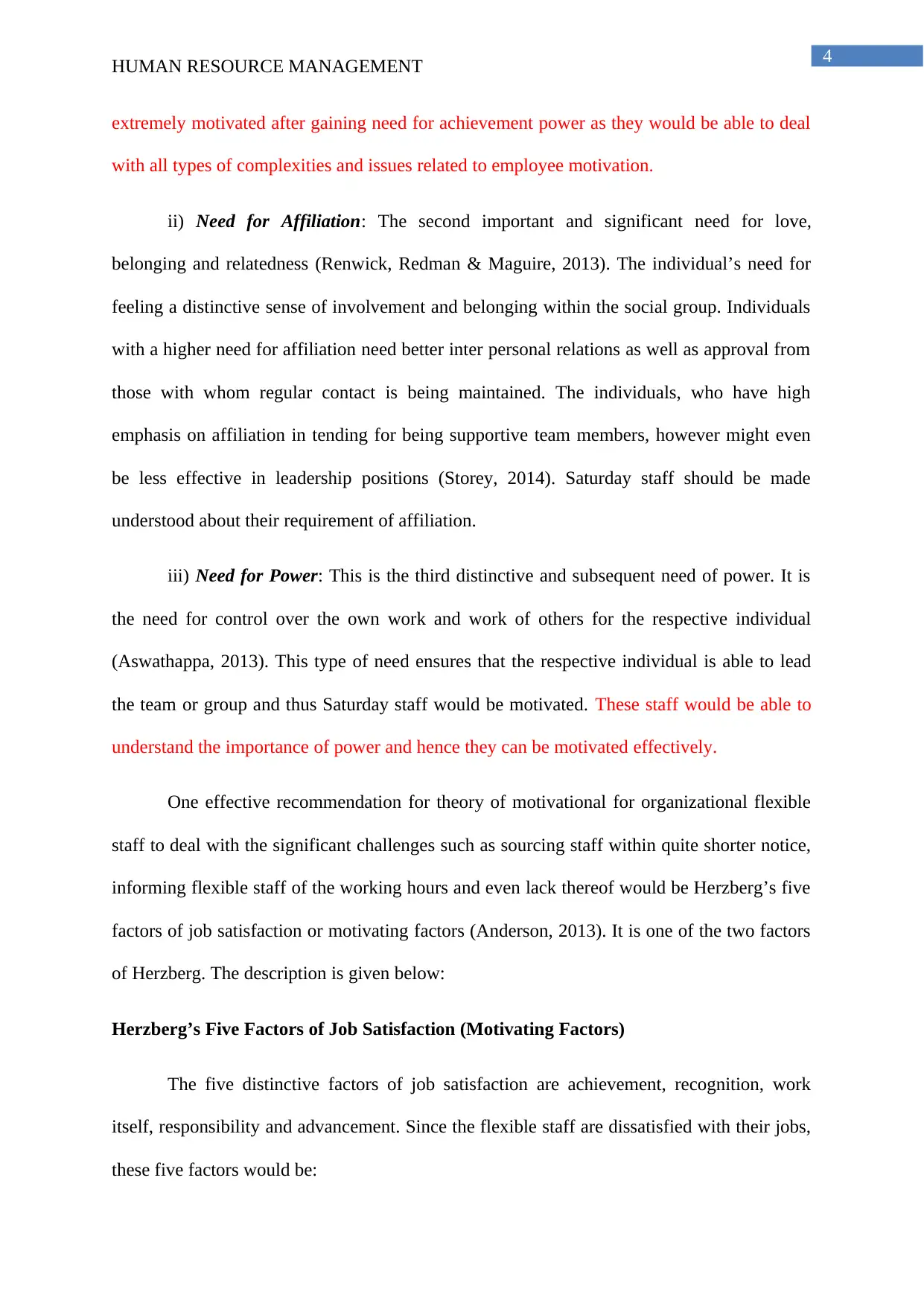
4
HUMAN RESOURCE MANAGEMENT
extremely motivated after gaining need for achievement power as they would be able to deal
with all types of complexities and issues related to employee motivation.
ii) Need for Affiliation: The second important and significant need for love,
belonging and relatedness (Renwick, Redman & Maguire, 2013). The individual’s need for
feeling a distinctive sense of involvement and belonging within the social group. Individuals
with a higher need for affiliation need better inter personal relations as well as approval from
those with whom regular contact is being maintained. The individuals, who have high
emphasis on affiliation in tending for being supportive team members, however might even
be less effective in leadership positions (Storey, 2014). Saturday staff should be made
understood about their requirement of affiliation.
iii) Need for Power: This is the third distinctive and subsequent need of power. It is
the need for control over the own work and work of others for the respective individual
(Aswathappa, 2013). This type of need ensures that the respective individual is able to lead
the team or group and thus Saturday staff would be motivated. These staff would be able to
understand the importance of power and hence they can be motivated effectively.
One effective recommendation for theory of motivational for organizational flexible
staff to deal with the significant challenges such as sourcing staff within quite shorter notice,
informing flexible staff of the working hours and even lack thereof would be Herzberg’s five
factors of job satisfaction or motivating factors (Anderson, 2013). It is one of the two factors
of Herzberg. The description is given below:
Herzberg’s Five Factors of Job Satisfaction (Motivating Factors)
The five distinctive factors of job satisfaction are achievement, recognition, work
itself, responsibility and advancement. Since the flexible staff are dissatisfied with their jobs,
these five factors would be:
HUMAN RESOURCE MANAGEMENT
extremely motivated after gaining need for achievement power as they would be able to deal
with all types of complexities and issues related to employee motivation.
ii) Need for Affiliation: The second important and significant need for love,
belonging and relatedness (Renwick, Redman & Maguire, 2013). The individual’s need for
feeling a distinctive sense of involvement and belonging within the social group. Individuals
with a higher need for affiliation need better inter personal relations as well as approval from
those with whom regular contact is being maintained. The individuals, who have high
emphasis on affiliation in tending for being supportive team members, however might even
be less effective in leadership positions (Storey, 2014). Saturday staff should be made
understood about their requirement of affiliation.
iii) Need for Power: This is the third distinctive and subsequent need of power. It is
the need for control over the own work and work of others for the respective individual
(Aswathappa, 2013). This type of need ensures that the respective individual is able to lead
the team or group and thus Saturday staff would be motivated. These staff would be able to
understand the importance of power and hence they can be motivated effectively.
One effective recommendation for theory of motivational for organizational flexible
staff to deal with the significant challenges such as sourcing staff within quite shorter notice,
informing flexible staff of the working hours and even lack thereof would be Herzberg’s five
factors of job satisfaction or motivating factors (Anderson, 2013). It is one of the two factors
of Herzberg. The description is given below:
Herzberg’s Five Factors of Job Satisfaction (Motivating Factors)
The five distinctive factors of job satisfaction are achievement, recognition, work
itself, responsibility and advancement. Since the flexible staff are dissatisfied with their jobs,
these five factors would be:
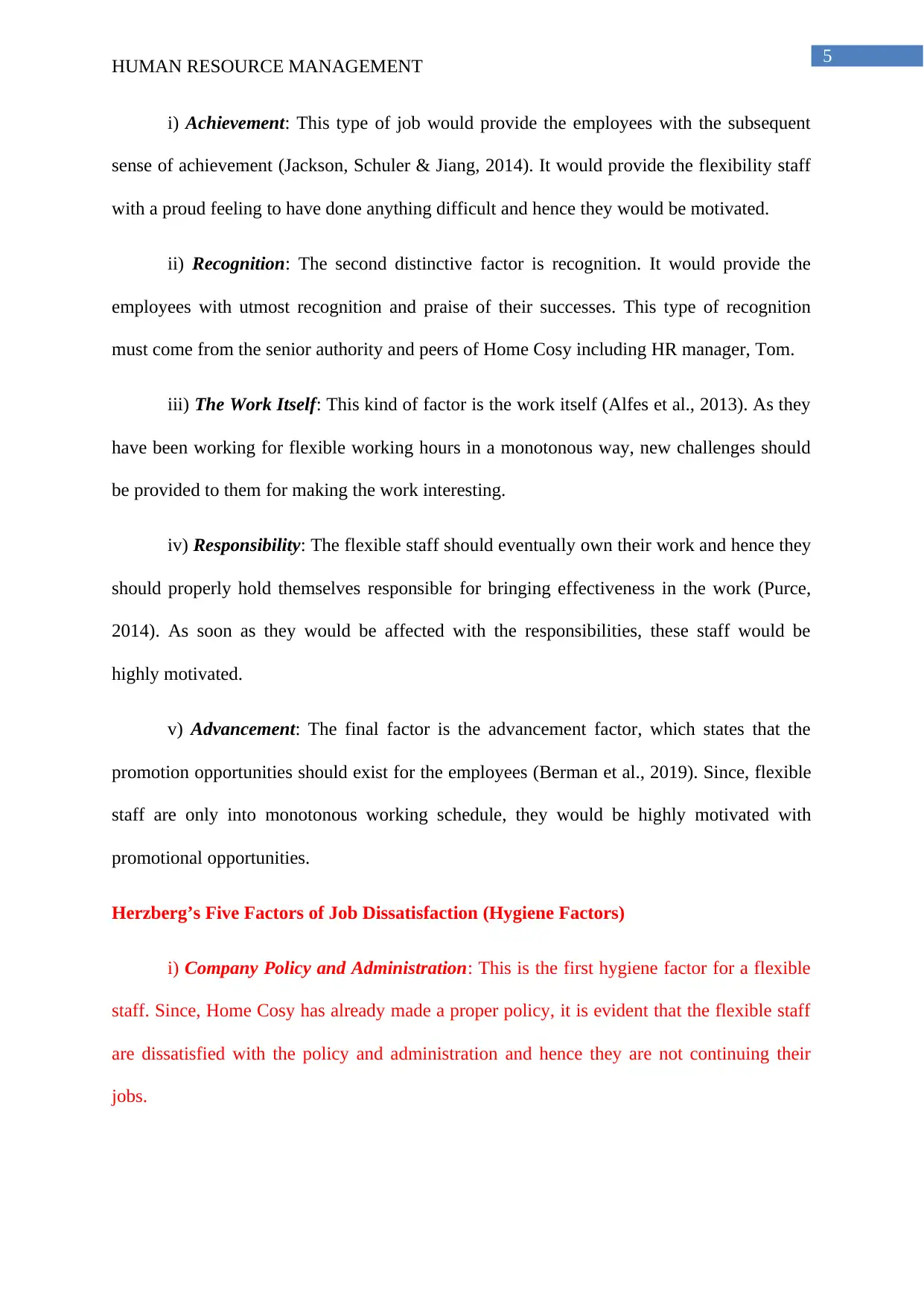
5
HUMAN RESOURCE MANAGEMENT
i) Achievement: This type of job would provide the employees with the subsequent
sense of achievement (Jackson, Schuler & Jiang, 2014). It would provide the flexibility staff
with a proud feeling to have done anything difficult and hence they would be motivated.
ii) Recognition: The second distinctive factor is recognition. It would provide the
employees with utmost recognition and praise of their successes. This type of recognition
must come from the senior authority and peers of Home Cosy including HR manager, Tom.
iii) The Work Itself: This kind of factor is the work itself (Alfes et al., 2013). As they
have been working for flexible working hours in a monotonous way, new challenges should
be provided to them for making the work interesting.
iv) Responsibility: The flexible staff should eventually own their work and hence they
should properly hold themselves responsible for bringing effectiveness in the work (Purce,
2014). As soon as they would be affected with the responsibilities, these staff would be
highly motivated.
v) Advancement: The final factor is the advancement factor, which states that the
promotion opportunities should exist for the employees (Berman et al., 2019). Since, flexible
staff are only into monotonous working schedule, they would be highly motivated with
promotional opportunities.
Herzberg’s Five Factors of Job Dissatisfaction (Hygiene Factors)
i) Company Policy and Administration: This is the first hygiene factor for a flexible
staff. Since, Home Cosy has already made a proper policy, it is evident that the flexible staff
are dissatisfied with the policy and administration and hence they are not continuing their
jobs.
HUMAN RESOURCE MANAGEMENT
i) Achievement: This type of job would provide the employees with the subsequent
sense of achievement (Jackson, Schuler & Jiang, 2014). It would provide the flexibility staff
with a proud feeling to have done anything difficult and hence they would be motivated.
ii) Recognition: The second distinctive factor is recognition. It would provide the
employees with utmost recognition and praise of their successes. This type of recognition
must come from the senior authority and peers of Home Cosy including HR manager, Tom.
iii) The Work Itself: This kind of factor is the work itself (Alfes et al., 2013). As they
have been working for flexible working hours in a monotonous way, new challenges should
be provided to them for making the work interesting.
iv) Responsibility: The flexible staff should eventually own their work and hence they
should properly hold themselves responsible for bringing effectiveness in the work (Purce,
2014). As soon as they would be affected with the responsibilities, these staff would be
highly motivated.
v) Advancement: The final factor is the advancement factor, which states that the
promotion opportunities should exist for the employees (Berman et al., 2019). Since, flexible
staff are only into monotonous working schedule, they would be highly motivated with
promotional opportunities.
Herzberg’s Five Factors of Job Dissatisfaction (Hygiene Factors)
i) Company Policy and Administration: This is the first hygiene factor for a flexible
staff. Since, Home Cosy has already made a proper policy, it is evident that the flexible staff
are dissatisfied with the policy and administration and hence they are not continuing their
jobs.
⊘ This is a preview!⊘
Do you want full access?
Subscribe today to unlock all pages.

Trusted by 1+ million students worldwide
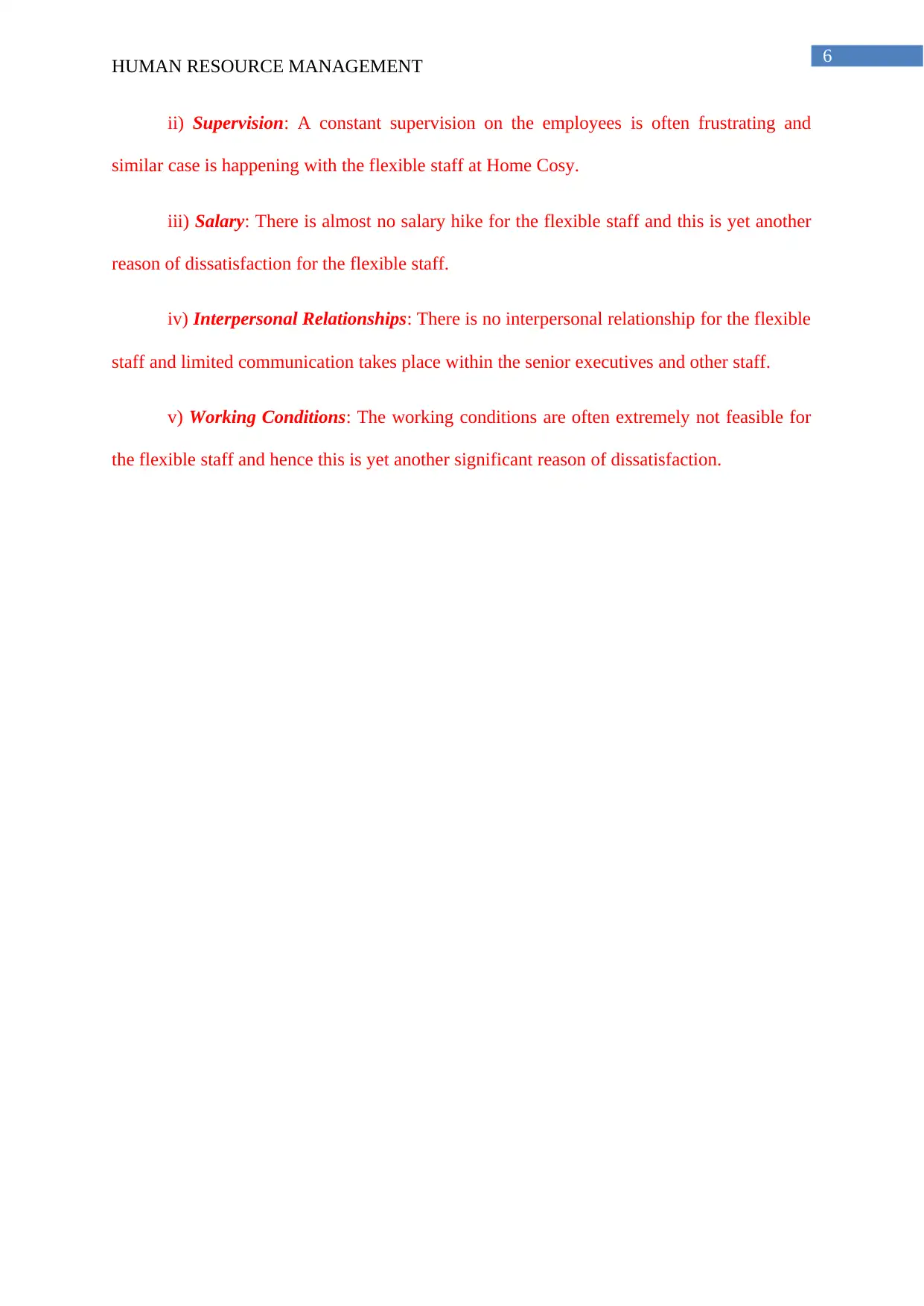
6
HUMAN RESOURCE MANAGEMENT
ii) Supervision: A constant supervision on the employees is often frustrating and
similar case is happening with the flexible staff at Home Cosy.
iii) Salary: There is almost no salary hike for the flexible staff and this is yet another
reason of dissatisfaction for the flexible staff.
iv) Interpersonal Relationships: There is no interpersonal relationship for the flexible
staff and limited communication takes place within the senior executives and other staff.
v) Working Conditions: The working conditions are often extremely not feasible for
the flexible staff and hence this is yet another significant reason of dissatisfaction.
HUMAN RESOURCE MANAGEMENT
ii) Supervision: A constant supervision on the employees is often frustrating and
similar case is happening with the flexible staff at Home Cosy.
iii) Salary: There is almost no salary hike for the flexible staff and this is yet another
reason of dissatisfaction for the flexible staff.
iv) Interpersonal Relationships: There is no interpersonal relationship for the flexible
staff and limited communication takes place within the senior executives and other staff.
v) Working Conditions: The working conditions are often extremely not feasible for
the flexible staff and hence this is yet another significant reason of dissatisfaction.
Paraphrase This Document
Need a fresh take? Get an instant paraphrase of this document with our AI Paraphraser
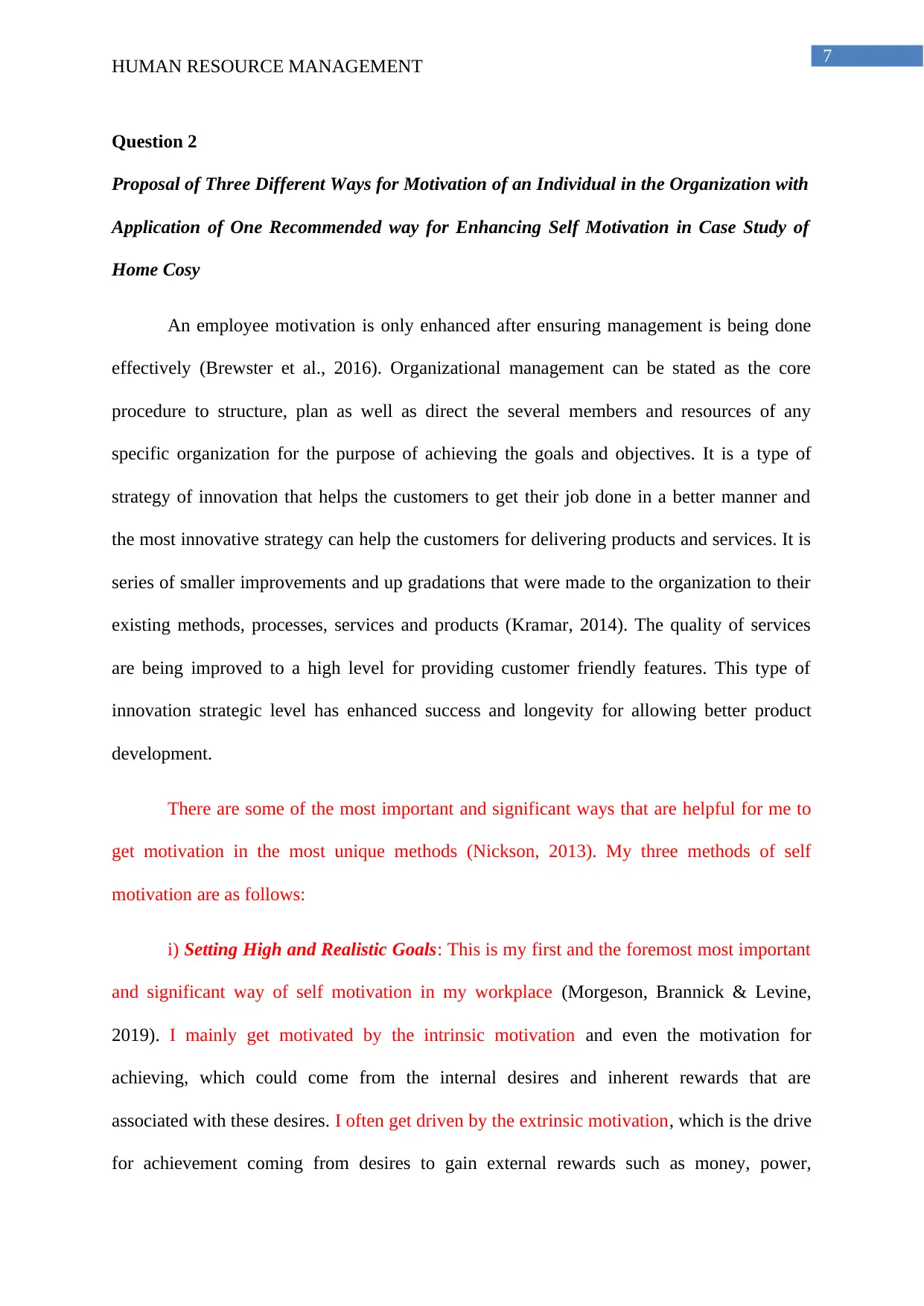
7
HUMAN RESOURCE MANAGEMENT
Question 2
Proposal of Three Different Ways for Motivation of an Individual in the Organization with
Application of One Recommended way for Enhancing Self Motivation in Case Study of
Home Cosy
An employee motivation is only enhanced after ensuring management is being done
effectively (Brewster et al., 2016). Organizational management can be stated as the core
procedure to structure, plan as well as direct the several members and resources of any
specific organization for the purpose of achieving the goals and objectives. It is a type of
strategy of innovation that helps the customers to get their job done in a better manner and
the most innovative strategy can help the customers for delivering products and services. It is
series of smaller improvements and up gradations that were made to the organization to their
existing methods, processes, services and products (Kramar, 2014). The quality of services
are being improved to a high level for providing customer friendly features. This type of
innovation strategic level has enhanced success and longevity for allowing better product
development.
There are some of the most important and significant ways that are helpful for me to
get motivation in the most unique methods (Nickson, 2013). My three methods of self
motivation are as follows:
i) Setting High and Realistic Goals: This is my first and the foremost most important
and significant way of self motivation in my workplace (Morgeson, Brannick & Levine,
2019). I mainly get motivated by the intrinsic motivation and even the motivation for
achieving, which could come from the internal desires and inherent rewards that are
associated with these desires. I often get driven by the extrinsic motivation, which is the drive
for achievement coming from desires to gain external rewards such as money, power,
HUMAN RESOURCE MANAGEMENT
Question 2
Proposal of Three Different Ways for Motivation of an Individual in the Organization with
Application of One Recommended way for Enhancing Self Motivation in Case Study of
Home Cosy
An employee motivation is only enhanced after ensuring management is being done
effectively (Brewster et al., 2016). Organizational management can be stated as the core
procedure to structure, plan as well as direct the several members and resources of any
specific organization for the purpose of achieving the goals and objectives. It is a type of
strategy of innovation that helps the customers to get their job done in a better manner and
the most innovative strategy can help the customers for delivering products and services. It is
series of smaller improvements and up gradations that were made to the organization to their
existing methods, processes, services and products (Kramar, 2014). The quality of services
are being improved to a high level for providing customer friendly features. This type of
innovation strategic level has enhanced success and longevity for allowing better product
development.
There are some of the most important and significant ways that are helpful for me to
get motivation in the most unique methods (Nickson, 2013). My three methods of self
motivation are as follows:
i) Setting High and Realistic Goals: This is my first and the foremost most important
and significant way of self motivation in my workplace (Morgeson, Brannick & Levine,
2019). I mainly get motivated by the intrinsic motivation and even the motivation for
achieving, which could come from the internal desires and inherent rewards that are
associated with these desires. I often get driven by the extrinsic motivation, which is the drive
for achievement coming from desires to gain external rewards such as money, power,
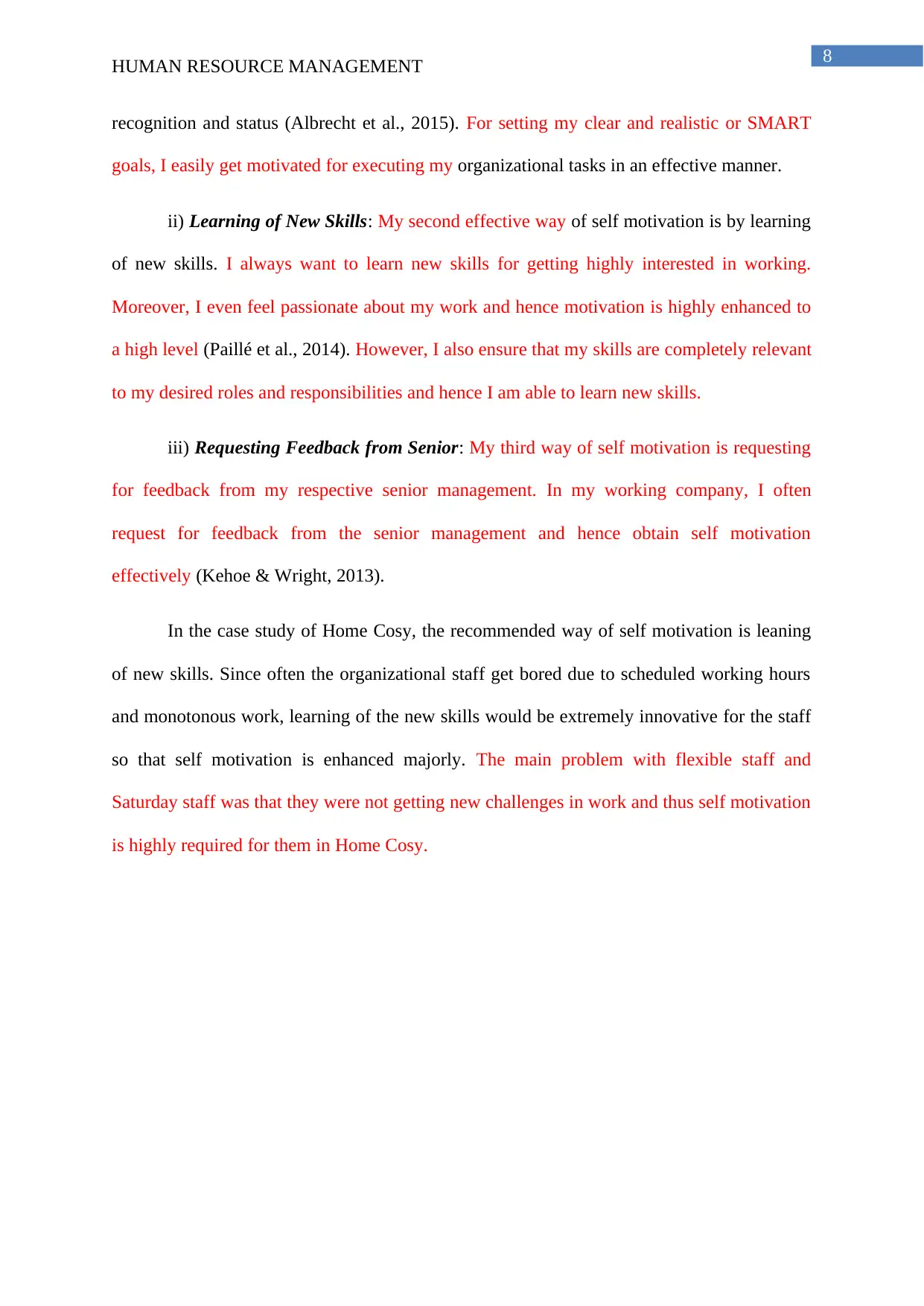
8
HUMAN RESOURCE MANAGEMENT
recognition and status (Albrecht et al., 2015). For setting my clear and realistic or SMART
goals, I easily get motivated for executing my organizational tasks in an effective manner.
ii) Learning of New Skills: My second effective way of self motivation is by learning
of new skills. I always want to learn new skills for getting highly interested in working.
Moreover, I even feel passionate about my work and hence motivation is highly enhanced to
a high level (Paillé et al., 2014). However, I also ensure that my skills are completely relevant
to my desired roles and responsibilities and hence I am able to learn new skills.
iii) Requesting Feedback from Senior: My third way of self motivation is requesting
for feedback from my respective senior management. In my working company, I often
request for feedback from the senior management and hence obtain self motivation
effectively (Kehoe & Wright, 2013).
In the case study of Home Cosy, the recommended way of self motivation is leaning
of new skills. Since often the organizational staff get bored due to scheduled working hours
and monotonous work, learning of the new skills would be extremely innovative for the staff
so that self motivation is enhanced majorly. The main problem with flexible staff and
Saturday staff was that they were not getting new challenges in work and thus self motivation
is highly required for them in Home Cosy.
HUMAN RESOURCE MANAGEMENT
recognition and status (Albrecht et al., 2015). For setting my clear and realistic or SMART
goals, I easily get motivated for executing my organizational tasks in an effective manner.
ii) Learning of New Skills: My second effective way of self motivation is by learning
of new skills. I always want to learn new skills for getting highly interested in working.
Moreover, I even feel passionate about my work and hence motivation is highly enhanced to
a high level (Paillé et al., 2014). However, I also ensure that my skills are completely relevant
to my desired roles and responsibilities and hence I am able to learn new skills.
iii) Requesting Feedback from Senior: My third way of self motivation is requesting
for feedback from my respective senior management. In my working company, I often
request for feedback from the senior management and hence obtain self motivation
effectively (Kehoe & Wright, 2013).
In the case study of Home Cosy, the recommended way of self motivation is leaning
of new skills. Since often the organizational staff get bored due to scheduled working hours
and monotonous work, learning of the new skills would be extremely innovative for the staff
so that self motivation is enhanced majorly. The main problem with flexible staff and
Saturday staff was that they were not getting new challenges in work and thus self motivation
is highly required for them in Home Cosy.
⊘ This is a preview!⊘
Do you want full access?
Subscribe today to unlock all pages.

Trusted by 1+ million students worldwide
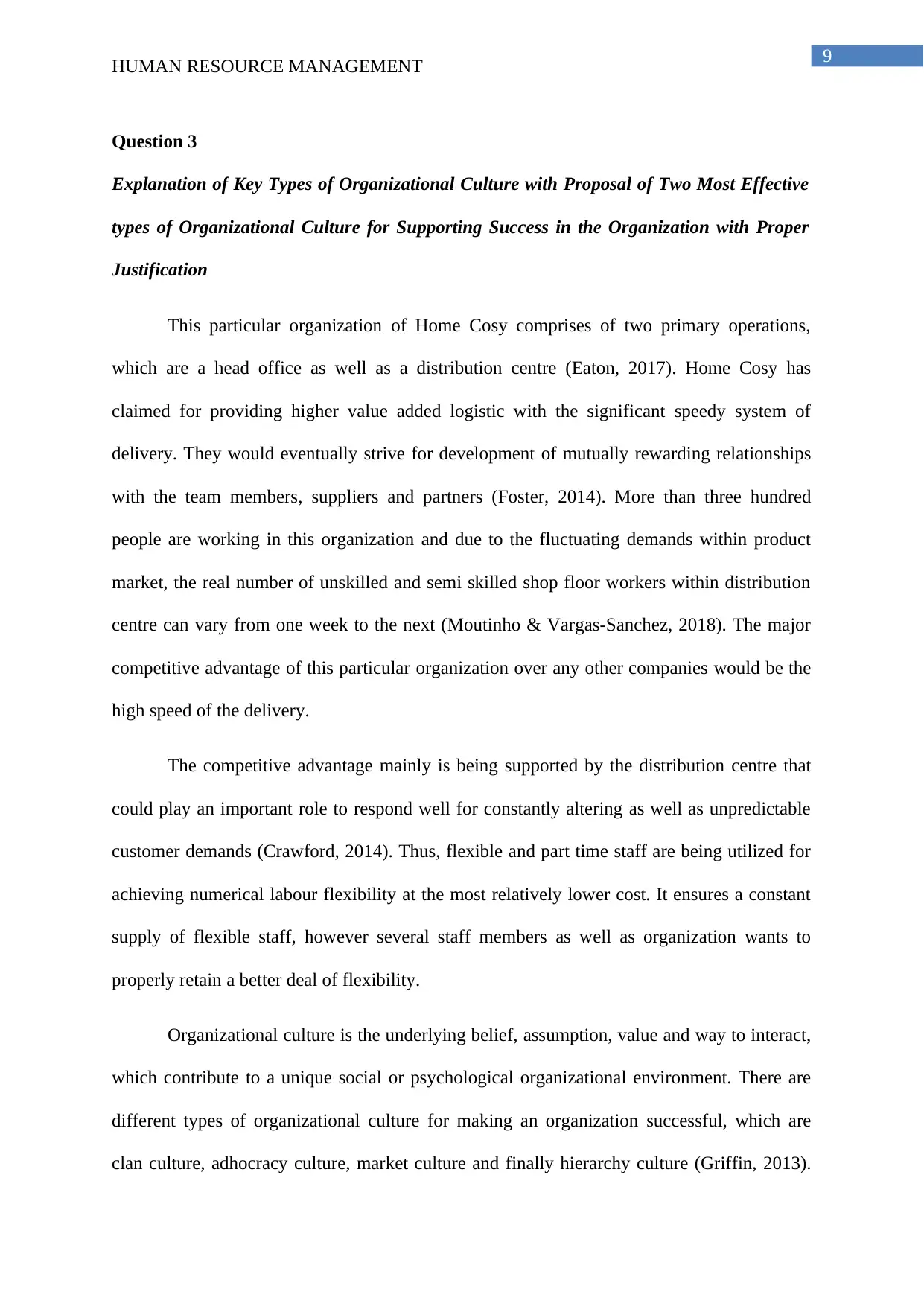
9
HUMAN RESOURCE MANAGEMENT
Question 3
Explanation of Key Types of Organizational Culture with Proposal of Two Most Effective
types of Organizational Culture for Supporting Success in the Organization with Proper
Justification
This particular organization of Home Cosy comprises of two primary operations,
which are a head office as well as a distribution centre (Eaton, 2017). Home Cosy has
claimed for providing higher value added logistic with the significant speedy system of
delivery. They would eventually strive for development of mutually rewarding relationships
with the team members, suppliers and partners (Foster, 2014). More than three hundred
people are working in this organization and due to the fluctuating demands within product
market, the real number of unskilled and semi skilled shop floor workers within distribution
centre can vary from one week to the next (Moutinho & Vargas-Sanchez, 2018). The major
competitive advantage of this particular organization over any other companies would be the
high speed of the delivery.
The competitive advantage mainly is being supported by the distribution centre that
could play an important role to respond well for constantly altering as well as unpredictable
customer demands (Crawford, 2014). Thus, flexible and part time staff are being utilized for
achieving numerical labour flexibility at the most relatively lower cost. It ensures a constant
supply of flexible staff, however several staff members as well as organization wants to
properly retain a better deal of flexibility.
Organizational culture is the underlying belief, assumption, value and way to interact,
which contribute to a unique social or psychological organizational environment. There are
different types of organizational culture for making an organization successful, which are
clan culture, adhocracy culture, market culture and finally hierarchy culture (Griffin, 2013).
HUMAN RESOURCE MANAGEMENT
Question 3
Explanation of Key Types of Organizational Culture with Proposal of Two Most Effective
types of Organizational Culture for Supporting Success in the Organization with Proper
Justification
This particular organization of Home Cosy comprises of two primary operations,
which are a head office as well as a distribution centre (Eaton, 2017). Home Cosy has
claimed for providing higher value added logistic with the significant speedy system of
delivery. They would eventually strive for development of mutually rewarding relationships
with the team members, suppliers and partners (Foster, 2014). More than three hundred
people are working in this organization and due to the fluctuating demands within product
market, the real number of unskilled and semi skilled shop floor workers within distribution
centre can vary from one week to the next (Moutinho & Vargas-Sanchez, 2018). The major
competitive advantage of this particular organization over any other companies would be the
high speed of the delivery.
The competitive advantage mainly is being supported by the distribution centre that
could play an important role to respond well for constantly altering as well as unpredictable
customer demands (Crawford, 2014). Thus, flexible and part time staff are being utilized for
achieving numerical labour flexibility at the most relatively lower cost. It ensures a constant
supply of flexible staff, however several staff members as well as organization wants to
properly retain a better deal of flexibility.
Organizational culture is the underlying belief, assumption, value and way to interact,
which contribute to a unique social or psychological organizational environment. There are
different types of organizational culture for making an organization successful, which are
clan culture, adhocracy culture, market culture and finally hierarchy culture (Griffin, 2013).
Paraphrase This Document
Need a fresh take? Get an instant paraphrase of this document with our AI Paraphraser
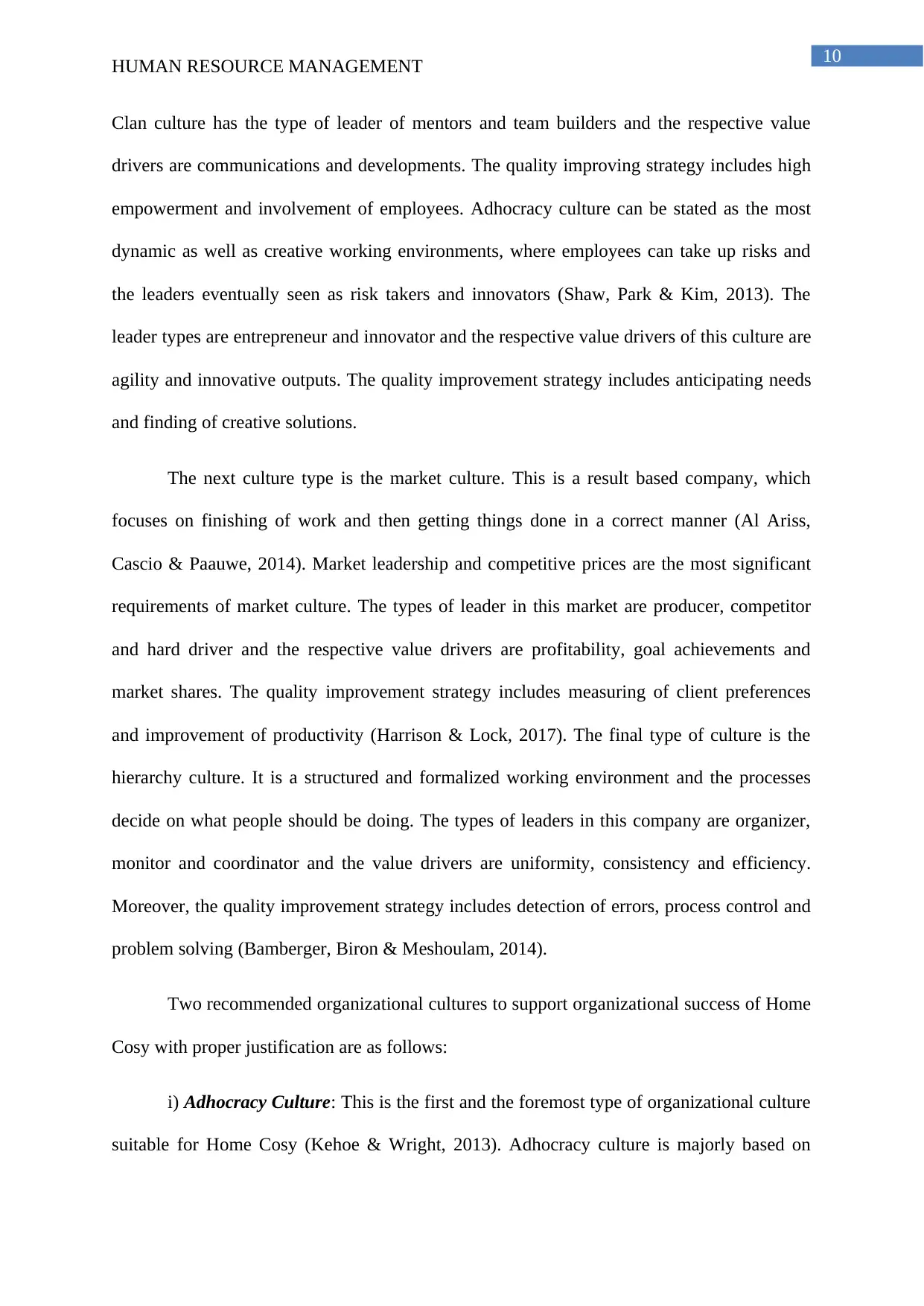
10
HUMAN RESOURCE MANAGEMENT
Clan culture has the type of leader of mentors and team builders and the respective value
drivers are communications and developments. The quality improving strategy includes high
empowerment and involvement of employees. Adhocracy culture can be stated as the most
dynamic as well as creative working environments, where employees can take up risks and
the leaders eventually seen as risk takers and innovators (Shaw, Park & Kim, 2013). The
leader types are entrepreneur and innovator and the respective value drivers of this culture are
agility and innovative outputs. The quality improvement strategy includes anticipating needs
and finding of creative solutions.
The next culture type is the market culture. This is a result based company, which
focuses on finishing of work and then getting things done in a correct manner (Al Ariss,
Cascio & Paauwe, 2014). Market leadership and competitive prices are the most significant
requirements of market culture. The types of leader in this market are producer, competitor
and hard driver and the respective value drivers are profitability, goal achievements and
market shares. The quality improvement strategy includes measuring of client preferences
and improvement of productivity (Harrison & Lock, 2017). The final type of culture is the
hierarchy culture. It is a structured and formalized working environment and the processes
decide on what people should be doing. The types of leaders in this company are organizer,
monitor and coordinator and the value drivers are uniformity, consistency and efficiency.
Moreover, the quality improvement strategy includes detection of errors, process control and
problem solving (Bamberger, Biron & Meshoulam, 2014).
Two recommended organizational cultures to support organizational success of Home
Cosy with proper justification are as follows:
i) Adhocracy Culture: This is the first and the foremost type of organizational culture
suitable for Home Cosy (Kehoe & Wright, 2013). Adhocracy culture is majorly based on
HUMAN RESOURCE MANAGEMENT
Clan culture has the type of leader of mentors and team builders and the respective value
drivers are communications and developments. The quality improving strategy includes high
empowerment and involvement of employees. Adhocracy culture can be stated as the most
dynamic as well as creative working environments, where employees can take up risks and
the leaders eventually seen as risk takers and innovators (Shaw, Park & Kim, 2013). The
leader types are entrepreneur and innovator and the respective value drivers of this culture are
agility and innovative outputs. The quality improvement strategy includes anticipating needs
and finding of creative solutions.
The next culture type is the market culture. This is a result based company, which
focuses on finishing of work and then getting things done in a correct manner (Al Ariss,
Cascio & Paauwe, 2014). Market leadership and competitive prices are the most significant
requirements of market culture. The types of leader in this market are producer, competitor
and hard driver and the respective value drivers are profitability, goal achievements and
market shares. The quality improvement strategy includes measuring of client preferences
and improvement of productivity (Harrison & Lock, 2017). The final type of culture is the
hierarchy culture. It is a structured and formalized working environment and the processes
decide on what people should be doing. The types of leaders in this company are organizer,
monitor and coordinator and the value drivers are uniformity, consistency and efficiency.
Moreover, the quality improvement strategy includes detection of errors, process control and
problem solving (Bamberger, Biron & Meshoulam, 2014).
Two recommended organizational cultures to support organizational success of Home
Cosy with proper justification are as follows:
i) Adhocracy Culture: This is the first and the foremost type of organizational culture
suitable for Home Cosy (Kehoe & Wright, 2013). Adhocracy culture is majorly based on
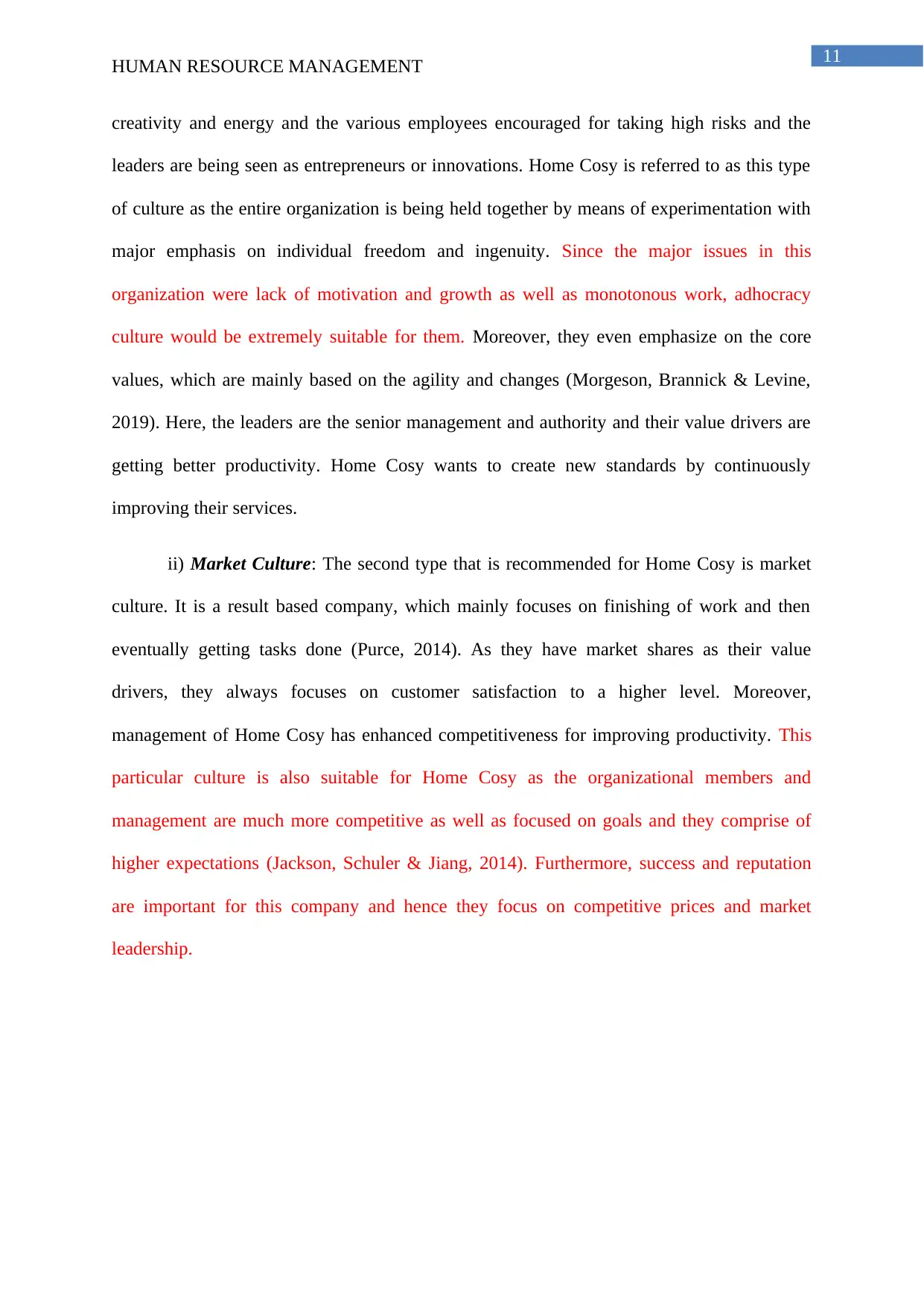
11
HUMAN RESOURCE MANAGEMENT
creativity and energy and the various employees encouraged for taking high risks and the
leaders are being seen as entrepreneurs or innovations. Home Cosy is referred to as this type
of culture as the entire organization is being held together by means of experimentation with
major emphasis on individual freedom and ingenuity. Since the major issues in this
organization were lack of motivation and growth as well as monotonous work, adhocracy
culture would be extremely suitable for them. Moreover, they even emphasize on the core
values, which are mainly based on the agility and changes (Morgeson, Brannick & Levine,
2019). Here, the leaders are the senior management and authority and their value drivers are
getting better productivity. Home Cosy wants to create new standards by continuously
improving their services.
ii) Market Culture: The second type that is recommended for Home Cosy is market
culture. It is a result based company, which mainly focuses on finishing of work and then
eventually getting tasks done (Purce, 2014). As they have market shares as their value
drivers, they always focuses on customer satisfaction to a higher level. Moreover,
management of Home Cosy has enhanced competitiveness for improving productivity. This
particular culture is also suitable for Home Cosy as the organizational members and
management are much more competitive as well as focused on goals and they comprise of
higher expectations (Jackson, Schuler & Jiang, 2014). Furthermore, success and reputation
are important for this company and hence they focus on competitive prices and market
leadership.
HUMAN RESOURCE MANAGEMENT
creativity and energy and the various employees encouraged for taking high risks and the
leaders are being seen as entrepreneurs or innovations. Home Cosy is referred to as this type
of culture as the entire organization is being held together by means of experimentation with
major emphasis on individual freedom and ingenuity. Since the major issues in this
organization were lack of motivation and growth as well as monotonous work, adhocracy
culture would be extremely suitable for them. Moreover, they even emphasize on the core
values, which are mainly based on the agility and changes (Morgeson, Brannick & Levine,
2019). Here, the leaders are the senior management and authority and their value drivers are
getting better productivity. Home Cosy wants to create new standards by continuously
improving their services.
ii) Market Culture: The second type that is recommended for Home Cosy is market
culture. It is a result based company, which mainly focuses on finishing of work and then
eventually getting tasks done (Purce, 2014). As they have market shares as their value
drivers, they always focuses on customer satisfaction to a higher level. Moreover,
management of Home Cosy has enhanced competitiveness for improving productivity. This
particular culture is also suitable for Home Cosy as the organizational members and
management are much more competitive as well as focused on goals and they comprise of
higher expectations (Jackson, Schuler & Jiang, 2014). Furthermore, success and reputation
are important for this company and hence they focus on competitive prices and market
leadership.
⊘ This is a preview!⊘
Do you want full access?
Subscribe today to unlock all pages.

Trusted by 1+ million students worldwide
1 out of 22
Related Documents
Your All-in-One AI-Powered Toolkit for Academic Success.
+13062052269
info@desklib.com
Available 24*7 on WhatsApp / Email
![[object Object]](/_next/static/media/star-bottom.7253800d.svg)
Unlock your academic potential
Copyright © 2020–2025 A2Z Services. All Rights Reserved. Developed and managed by ZUCOL.





